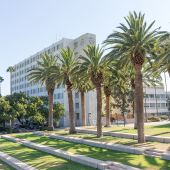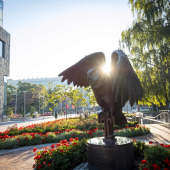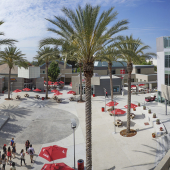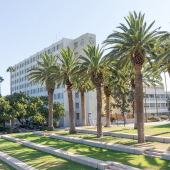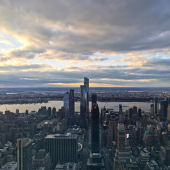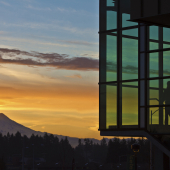Did you know there are nearly 400 national parks in the United States? Summer is a great time to take advantage of all they have to offer — hiking, camping, exploring nature and more. Even better: Entry is generally free, and fees for activities such as camping are low, making a holiday to a national park a great deal for student travel. Here’s a look at the five most popular national parks in the U.S.
1. Great Smoky Mountains National Park

Nearest major airports: 1 hour from Knoxville, TN; in Asheville, NC’s backyard, and 2 hours from Charlotte, NC; 2.5 to 3 Hours from Greenville/Spartanburg, SC.
At a glance: The human history of the Great Smoky Mountains — some of the oldest mountains in the world — stretches back to prehistoric Paleo-Indians. Over 800 square miles, you’ll find over 17,000 species of plants, animals and invertebrates — and there may be an additional 30,000 to 80,000. The National Park Service says “No other area of equal size in a temperate climate can match the park's amazing diversity” of flora and fauna. Summer in the Great Smoky Mountains features lots of rain and humidity, so bring your waterproof gear.
More info: Great Smoky Mountains National Park - website http://www.nps.gov/grsm/index.htm.
2. Grand Canyon National Park

Nearest major airports: 4 hours from Phoenix, AZ; 5 hours from Las Vegas, NV, to the South Rim
At a glance: The Colorado River runs through the 1-mile-deep Grand Canyon that separates the national park into North and South Rims. The South Rim is the more accessible — it’s the one you’ll usually see in tourists’ photos — and open year-round. Just 10 miles away (but a 21-mile hike, or a 215-mile drive) is the North Rim, a thousand feet higher and prone to heavy snows (it’s closed from late October to mid-May of each year). The Grand Canyon, 277 miles long and 18 miles across at some points, features an inner canyon where students looking for adventure can ride a mule to Phantom Ranch or take a several-day river trip.
If you want to hike to the bottom of the Grand Canyon and back, it’ll take you about 2 days. South Rim camping, lodging and restaurants are available year-round; the National Park Service recommends reservations during summer.
More info: Grand Canyon National Park - website http://www.nps.gov/grca/index.htm.
3. Yosemite National Park

Nearest major airports: About 4 hours from San Francisco, CA, or San Jose, CA; 3.5 hours from Sacramento, CA, or Reno, NV
At a glance: Nestled in the Sierra Nevada, Yosemite National Park features deep valleys, vast meadows, awe-inspiring waterfalls (best in spring — perhaps getting away from it all is in order for spring break this year?) and the famous giant sequoia trees. Inimitably shaped by glaciers, 95% of the park has been designated as “wilderness.” Over the 800 miles of hiking trails and 282 miles of road, you’ll be able to commune with over 400 species of vertebrates and at least two species of insects believed to exist nowhere else in the world. Lodging and camping are both available at Yosemite National Park; reservations are recommended.
More info: Yosemite National Park - website http://www.nps.gov/yose/index.htm.
4. Yellowstone National Park

Nearest major airports: None are really near Yellowstone National Park, however, commercial airlines do serve a number of smaller airports near the park: Cody and Jackson, WY; Bozeman and Billings, MT; and Idaho Falls, ID. West Yellowstone, MT, is open from June to early September via the Salt Lake City, UT airport. Note: You can catch a bus from Bozeman, MT, to West Yellowstone year-round, and from Idaho to West Yellowstone during summer.
At a glance: Yellowstone National Park was established in 1872, making it the oldest national park in the United States. Its North Entrance, on the edge of Gardiner, MT, is the only park entrance open year-round to vehicles. Yellowstone is most famous for its geysers — in fact, 60% of the world’s geysers are found here.
Old Faithful is the most notable of the more than 300 in the park, but did you know there are more than 10,000 thermal features all told in Yellowstone? These features include “brilliantly colored hot springs, bubbling mudpots, and steaming fumaroles,” and the largest hot spring in the United States, the Grand Prismatic Hot Spring. The mountainous terrain of Yellowstone National Park provides a home for grizzly bears, wolves, and herds of bison and elk.
More info: Yellowstone National Park - website http://www.nps.gov/yell/index.htm.
5. Olympic National Park

Nearest major airport: About 2.5 hours from Seattle-Tacoma, WA
At a glance: Open 365 days a year, Olympic National Park contains in its 1 million acres: beaches, rainforests, glaciers and many miles of hiking trails. Mount Olympus, at 7,980 feet tall, is the highest peak in Olympic National Park and is part of the third-largest glacial system in the continental United States. Another unique feature is that the park is home to the largest unmanaged herd of Roosevelt elk in the world. In fact, Olympic National Park was almost named "Elk National Park" when it was established. While Olympic National Park is designated 95% wilderness, there are several lodges, resorts and campgrounds if you want to stay overnight; be sure to make reservations.
More info: Olympic National Park - website http://www.nps.gov/olym/index.htm.
|
Taking a trip to a national park is the perfect opportunity to take in the beauty of nature, as unspoiled as it’s going to get. And being a college student means you can get great deals on flights, activities and hotels, and all your hiking and camping needs. So what are you waiting for? Geysers and grizzly bears and glaciers await! |
Source: Student Universe
